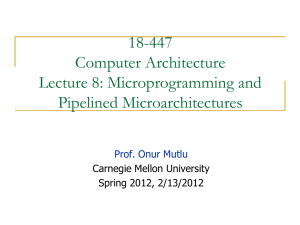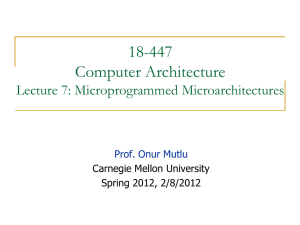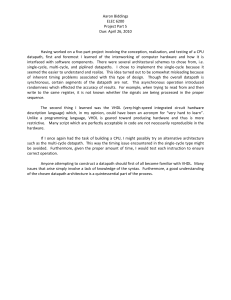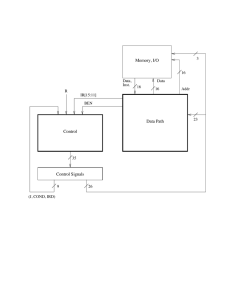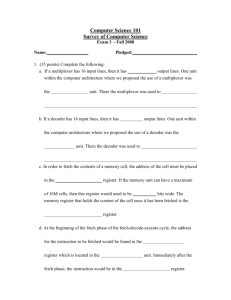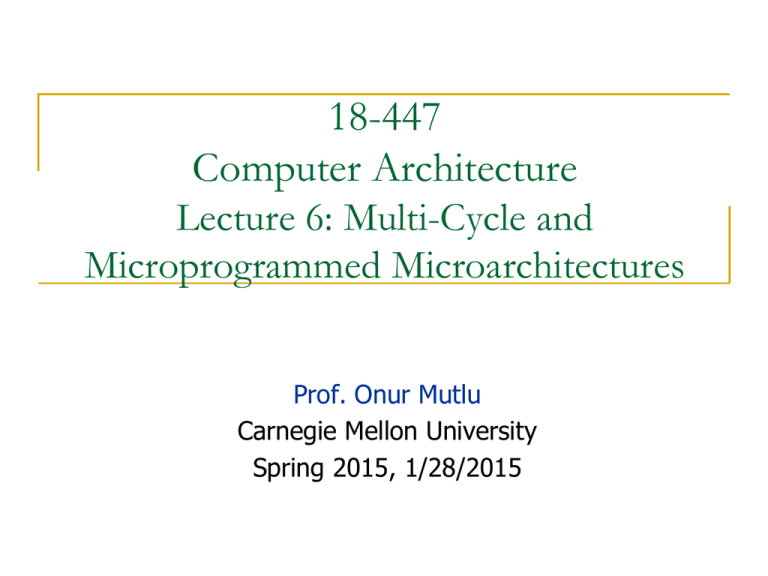
18-447
Computer Architecture
Lecture 6: Multi-Cycle and
Microprogrammed Microarchitectures
Prof. Onur Mutlu
Carnegie Mellon University
Spring 2015, 1/28/2015
Agenda for Today & Next Few Lectures
n
Single-cycle Microarchitectures
n
Multi-cycle and Microprogrammed Microarchitectures
n
Pipelining
n
Issues in Pipelining: Control & Data Dependence Handling,
State Maintenance and Recovery, …
n
Out-of-Order Execution
n
Issues in OoO Execution: Load-Store Handling, …
2
Reminder on Assignments
n
Lab 2 due next Friday (Feb 6)
q
Start early!
n
HW 1 due today
HW 2 out
n
Remember that all is for your benefit
n
q
q
Homeworks, especially so
All assignments can take time, but the goal is for you to learn
very well
3
Number of Students Lab 1 Grades
25 20 15 10 5 0 30 n
n
n
40 50 60 70 80 90 100 Mean: 88.0
Median: 96.0
Standard Deviation: 16.9
4
Extra Credit for Lab Assignment 2
n
n
n
n
n
n
Complete your normal (single-cycle) implementation first, and
get it checked off in lab.
Then, implement the MIPS core using a microcoded approach
similar to what we will discuss in class.
We are not specifying any particular details of the microcode
format or the microarchitecture; you can be creative.
For the extra credit, the microcoded implementation should
execute the same programs that your ordinary
implementation does, and you should demo it by the normal
lab deadline.
You will get maximum 4% of course grade
Document what you have done and demonstrate well
5
Readings for Today
n
P&P, Revised Appendix C
q
q
n
P&H, Appendix D
q
n
Microarchitecture of the LC-3b
Appendix A (LC-3b ISA) will be useful in following this
Mapping Control to Hardware
Optional
q
Maurice Wilkes, “The Best Way to Design an Automatic
Calculating Machine,” Manchester Univ. Computer Inaugural
Conf., 1951.
6
Readings for Next Lecture
n
Pipelining
q
n
P&H Chapter 4.5-4.8
Pipelined LC-3b Microarchitecture
q
http://www.ece.cmu.edu/~ece447/s14/lib/exe/fetch.php?
media=18447-lc3b-pipelining.pdf
7
Recap of Last Lecture
n
Intro to Microarchitecture: Single-cycle Microarchitectures
q
q
q
q
q
q
n
Detailed walkthrough of a single-cycle MIPS implementation
q
q
q
n
Single-cycle vs. multi-cycle
Instruction processing “cycle”
Datapath vs. control logic
Hardwired vs. microprogrammed control
Performance analysis: Execution time equation
Power analysis: Dynamic power equation
Datapath
Control logic
Critical path analysis
(Micro)architecture design principles
8
Review: A Key System Design Principle
n
n
Keep it simple
“Everything should be made as simple as possible, but no
simpler.”
q
n
n
Albert Einstein
And, keep it low cost: “An engineer is a person who can do
for a dime what any fool can do for a dollar.”
For more, see:
q
q
Butler W. Lampson, “Hints for Computer System Design,” ACM
Operating Systems Review, 1983.
http://research.microsoft.com/pubs/68221/acrobat.pdf
9
Review: (Micro)architecture Design Principles
n
Critical path design
q
q
n
Find and decrease the maximum combinational logic delay
Break a path into multiple cycles if it takes too long
Bread and butter (common case) design
q
Spend time and resources on where it matters most
n
q
n
i.e., improve what the machine is really designed to do
Common case vs. uncommon case
Balanced design
q
q
Balance instruction/data flow through hardware components
Design to eliminate bottlenecks: balance the hardware for the
work
10
Review: Single-Cycle Design vs. Design Principles
n
Critical path design
n
Bread and butter (common case) design
n
Balanced design
How does a single-cycle microarchitecture fare in light of
these principles?
11
Multi-Cycle Microarchitectures
12
Multi-Cycle Microarchitectures
n
n
Goal: Let each instruction take (close to) only as much time
it really needs
Idea
q
q
Determine clock cycle time independently of instruction
processing time
Each instruction takes as many clock cycles as it needs to take
n
n
Multiple state transitions per instruction
The states followed by each instruction is different
13
Remember: The “Process instruction” Step
n
ISA specifies abstractly what AS’ should be, given an
instruction and AS
q
It defines an abstract finite state machine where
n
n
q
From ISA point of view, there are no “intermediate states”
between AS and AS’ during instruction execution
n
n
State = programmer-visible state
Next-state logic = instruction execution specification
One state transition per instruction
Microarchitecture implements how AS is transformed to AS’
q
q
There are many choices in implementation
We can have programmer-invisible state to optimize the speed of
instruction execution: multiple state transitions per instruction
n
n
Choice 1: AS à AS’ (transform AS to AS’ in a single clock cycle)
Choice 2: AS à AS+MS1 à AS+MS2 à AS+MS3 à AS’ (take multiple
clock cycles to transform AS to AS’)
14
Multi-Cycle Microarchitecture
AS = Architectural (programmer visible) state
at the beginning of an instruction
Step 1: Process part of instruction in one clock cycle
Step 2: Process part of instruction in the next clock cycle
…
AS’ = Architectural (programmer visible) state
at the end of a clock cycle
15
Benefits of Multi-Cycle Design
n
Critical path design
q
n
Bread and butter (common case) design
q
n
Can keep reducing the critical path independently of the worstcase processing time of any instruction
Can optimize the number of states it takes to execute “important”
instructions that make up much of the execution time
Balanced design
q
No need to provide more capability or resources than really
needed
n
n
An instruction that needs resource X multiple times does not require
multiple X’s to be implemented
Leads to more efficient hardware: Can reuse hardware components
needed multiple times for an instruction
16
Remember: Performance Analysis
n
Execution time of an instruction
q
n
Execution time of a program
q
q
n
Sum over all instructions [{CPI} x {clock cycle time}]
{# of instructions} x {Average CPI} x {clock cycle time}
Single cycle microarchitecture performance
q
q
n
{CPI} x {clock cycle time}
CPI = 1
Clock cycle time = long
Multi-cycle microarchitecture performance
q
CPI = different for each instruction
n
q
Average CPI à hopefully small
Clock cycle time = short
Now, we have
two degrees of freedom
to optimize independently
17
A Multi-Cycle Microarchitecture
A Closer Look
18
How Do We Implement This?
n
n
Maurice Wilkes, “The Best Way to Design an Automatic
Calculating Machine,” Manchester Univ. Computer
Inaugural Conf., 1951.
The concept of microcoded/microprogrammed machines
19
Microprogrammed Multi-Cycle uArch
n
Key Idea for Realization
q
q
q
One can implement the “process instruction” step as a
finite state machine that sequences between states and
eventually returns back to the “fetch instruction” state
A state is defined by the control signals asserted in it
Control signals for the next state determined in current
state
20
The Instruction Processing Cycle
q
q
q
q
q
q
Fetch
Decode
Evaluate Address
Fetch Operands
Execute
Store Result
21
A Basic Multi-Cycle Microarchitecture
n
Instruction processing cycle divided into “states”
n
n
A multi-cycle microarchitecture sequences from state to
state to process an instruction
n
n
n
A stage in the instruction processing cycle can take multiple states
The behavior of the machine in a state is completely determined by
control signals in that state
The behavior of the entire processor is specified fully by a
finite state machine
In a state (clock cycle), control signals control two things:
n
n
How the datapath should process the data
How to generate the control signals for the next clock cycle
22
Microprogrammed Control Terminology
n
Control signals associated with the current state
q
n
Act of transitioning from one state to another
q
q
n
Determining the next state and the microinstruction for the
next state
Microsequencing
Control store stores control signals for every possible state
q
n
Microinstruction
Store for microinstructions for the entire FSM
Microsequencer determines which set of control signals will
be used in the next clock cycle (i.e., next state)
23
What Happens In A Clock Cycle?
n
The control signals (microinstruction) for the current state
control two things:
q
q
q
n
n
Processing in the data path
Generation of control signals (microinstruction) for the next
cycle
See Supplemental Figure 1 (next slide)
Datapath and microsequencer operate concurrently
Question: why not generate control signals for the current
cycle in the current cycle?
q
q
q
This will lengthen the clock cycle
Why would it lengthen the clock cycle?
See Supplemental Figure 2
24
A Clock Cycle
25
A Bad Clock Cycle!
26
A Simple LC-3b Control and Datapath
Read Appendix C
under Technical Docs
27
What Determines Next-State Control Signals?
n
What is happening in the current clock cycle
q
See the 9 control signals coming from “Control” block
n
n
The instruction that is being executed
q
n
IR[15:11] coming from the Data Path
Whether the condition of a branch is met, if the instruction
being processed is a branch
q
n
What are these for?
BEN bit coming from the datapath
Whether the memory operation is completing in the current
cycle, if one is in progress
q
R bit coming from memory
28
A Simple LC-3b Control and Datapath
29
The State Machine for Multi-Cycle Processing
n
The behavior of the LC-3b uarch is completely determined by
q
q
n
n
the 35 control signals and
additional 7 bits that go into the control logic from the datapath
35 control signals completely describe the state of the control
structure
We can completely describe the behavior of the LC-3b as a
state machine, i.e. a directed graph of
q
q
Nodes (one corresponding to each state)
Arcs (showing flow from each state to the next state(s))
30
An LC-3b State Machine
n
Patt and Patel, Appendix C, Figure C.2
n
Each state must be uniquely specified
q
n
31 distinct states in this LC-3b state machine
q
n
Done by means of state variables
Encoded with 6 state variables
Examples
q
q
q
State 18,19 correspond to the beginning of the instruction
processing cycle
Fetch phase: state 18, 19 à state 33 à state 35
Decode phase: state 32
31
18, 19
MAR <! PC
PC <! PC + 2
33
MDR <! M
R
R
35
IR <! MDR
32
RTI
To 8
1011
BEN<!IR[11] & N + IR[10] & Z + IR[9] & P
To 11
1010
[IR[15:12]]
ADD
To 10
BR
AND
DR<!SR1+OP2*
set CC
1
0
XOR
JMP
TRAP
To 18
DR<!SR1&OP2*
set CC
[BEN]
JSR
SHF
LEA
LDB
STW
LDW
STB
1
PC<!PC+LSHF(off9,1)
12
DR<!SR1 XOR OP2*
set CC
15
4
MAR<!LSHF(ZEXT[IR[7:0]],1)
To 18
[IR[11]]
0
R
To 18
PC<!BaseR
To 18
MDR<!M[MAR]
R7<!PC
22
5
9
To 18
0
1
20
28
R7<!PC
PC<!BaseR
R
21
30
PC<!MDR
To 18
To 18
R7<!PC
PC<!PC+LSHF(off11,1)
13
DR<!SHF(SR,A,D,amt4)
set CC
To 18
14
2
DR<!PC+LSHF(off9, 1)
set CC
To 18
MAR<!B+off6
6
7
MAR<!B+LSHF(off6,1)
3
MAR<!B+LSHF(off6,1)
MAR<!B+off6
To 18
29
NOTES
B+off6 : Base + SEXT[offset6]
PC+off9 : PC + SEXT[offset9]
*OP2 may be SR2 or SEXT[imm5]
** [15:8] or [7:0] depending on
MAR[0]
MDR<!M[MAR[15:1]’0]
R
31
R
DR<!SEXT[BYTE.DATA]
set CC
MDR<!SR
MDR<!M[MAR]
27
R
DR<!MDR
set CC
R
To 18
MDR<!SR[7:0]
16
17
M[MAR]<!MDR
R
To 18
24
23
25
To 18
M[MAR]<!MDR**
R
R
To 19
R
LC-3b State Machine: Some Questions
n
How many cycles does the fastest instruction take?
n
How many cycles does the slowest instruction take?
n
Why does the BR take as long as it takes in the FSM?
n
What determines the clock cycle time?
33
LC-3b Datapath
n
Patt and Patel, Appendix C, Figure C.3
n
Single-bus datapath design
q
q
q
n
At any point only one value can be “gated” on the bus (i.e.,
can be driving the bus)
Advantage: Low hardware cost: one bus
Disadvantage: Reduced concurrency – if instruction needs the
bus twice for two different things, these need to happen in
different states
Control signals (26 of them) determine what happens in the
datapath in one clock cycle
q
Patt and Patel, Appendix C, Table C.1
34
GateMARMUX
GatePC
16
16
16
LD.PC
MARMUX
16
2
16
PC
+2
PCMUX
REG
FILE
16
+
SR2
ZEXT &
LSHF1
[7:0]
LSHF1
ADDR1MUX
16
16
[10:0]
SR1
OUT
16
16
3
DR
SR1
16
16
16
0
SEXT
[4:0]
SR2
OUT
16
16
[5:0]
3
2
ADDR2MUX
[8:0]
3
LD.REG
16
SR2MUX
SEXT
SEXT
CONTROL
SEXT
R
LD.IR
IR
2
N Z P
LD.CC
16
B
ALUK
LOGIC
6
A
ALU
SHF
16
16
GateALU
IR[5:0]
GateSHF
16
GateMDR
MAR
L D .M AR
DATA.SIZE
[0]
LOGIC
R.W
WE
LOGIC
MAR[0]
MIO.EN
DATA.
SIZE
16
MEMORY
L D .MDR
MDR
MIO.EN
16
LOGIC
ADDR. CTL.
LOGIC
2
MEM.EN
R
16
DATA.SIZE
MAR[0]
INMUX
INPUT
OUTPUT
KBDR
WE1 WE0
DDR
KBSR
DSR
C.4. THE CONTROL STRUCTURE
11
IR[11:9]
IR[11:9]
DR
SR1
111
IR[8:6]
DRMUX
SR1MUX
(b)
(a)
Remember the MIPS datapath
IR[11:9]
N
Z
P
Logic
BEN
(c)
Figure C.6: Additional logic required to provide control signals
LC-3b Datapath: Some Questions
n
How does instruction fetch happen in this datapath
according to the state machine?
n
What is the difference between gating and loading?
n
Is this the smallest hardware you can design?
38
LC-3b Microprogrammed Control Structure
n
Patt and Patel, Appendix C, Figure C.4
n
Three components:
q
n
n
n
Microinstruction: control signals that control the datapath
(26 of them) and help determine the next state (9 of them)
Each microinstruction is stored in a unique location in the
control store (a special memory structure)
Unique location: address of the state corresponding to the
microinstruction
q
n
Microinstruction, control store, microsequencer
Remember each state corresponds to one microinstruction
Microsequencer determines the address of the next
microinstruction (i.e., next state)
39
R
IR[15:11]
BEN
Microsequencer
6
Control Store
2 6 x 35
35
Microinstruction
9
(J, COND, IRD)
26
10APPENDIX C. THE MICROARCHITECTURE OF THE LC-3B, BASIC MACHINE
COND1
BEN
R
J[4]
J[3]
J[2]
IR[11]
Ready
Branch
J[5]
COND0
J[1]
0,0,IR[15:12]
6
IRD
6
Address of Next State
Figure C.5: The microsequencer of the LC-3b base machine
Addr.
Mode
J[0]
J
d
Co
n
IR
D
LD
.M
LD AR
.M
LD DR
.IR
LD
.BE
LD N
.RE
LD G
.CC
LD
.PC
Ga
teP
Ga C
teM
Ga DR
teA
Ga LU
teM
Ga ARM
teS
HF UX
PC
MU
X
DR
MU
SR X
1M
AD UX
DR
1M
UX
AD
DR
2M
UX
MA
RM
UX
AL
UK
MI
O.
E
R.W N
DA
TA
LS .SIZ
HF E
1
000000 (State 0)
000001 (State 1)
000010 (State 2)
000011 (State 3)
000100 (State 4)
000101 (State 5)
000110 (State 6)
000111 (State 7)
001000 (State 8)
001001 (State 9)
001010 (State 10)
001011 (State 11)
001100 (State 12)
001101 (State 13)
001110 (State 14)
001111 (State 15)
010000 (State 16)
010001 (State 17)
010010 (State 18)
010011 (State 19)
010100 (State 20)
010101 (State 21)
010110 (State 22)
010111 (State 23)
011000 (State 24)
011001 (State 25)
011010 (State 26)
011011 (State 27)
011100 (State 28)
011101 (State 29)
011110 (State 30)
011111 (State 31)
100000 (State 32)
100001 (State 33)
100010 (State 34)
100011 (State 35)
100100 (State 36)
100101 (State 37)
100110 (State 38)
100111 (State 39)
101000 (State 40)
101001 (State 41)
101010 (State 42)
101011 (State 43)
101100 (State 44)
101101 (State 45)
101110 (State 46)
101111 (State 47)
110000 (State 48)
110001 (State 49)
110010 (State 50)
110011 (State 51)
110100 (State 52)
110101 (State 53)
110110 (State 54)
110111 (State 55)
111000 (State 56)
111001 (State 57)
111010 (State 58)
111011 (State 59)
111100 (State 60)
111101 (State 61)
111110 (State 62)
111111 (State 63)
LC-3b Microsequencer
n
n
n
Patt and Patel, Appendix C, Figure C.5
The purpose of the microsequencer is to determine the
address of the next microinstruction (i.e., next state)
Next address depends on 9 control signals (plus 7 data
signals)
43
10APPENDIX C. THE MICROARCHITECTURE OF THE LC-3B, BASIC MACHINE
COND1
BEN
R
J[4]
J[3]
J[2]
IR[11]
Ready
Branch
J[5]
COND0
J[1]
0,0,IR[15:12]
6
IRD
6
Address of Next State
Figure C.5: The microsequencer of the LC-3b base machine
Addr.
Mode
J[0]
The Microsequencer: Some Questions
n
When is the IRD signal asserted?
n
What happens if an illegal instruction is decoded?
n
What are condition (COND) bits for?
n
How is variable latency memory handled?
n
How do you do the state encoding?
q
q
q
Minimize number of state variables (~ control store size)
Start with the 16-way branch
Then determine constraint tables and states dependent on COND
45
An Exercise in
Microprogramming
46
Handouts
n
n
n
7 pages of Microprogrammed LC-3b design
http://www.ece.cmu.edu/~ece447/s14/doku.php?
id=techdocs
http://www.ece.cmu.edu/~ece447/s14/lib/exe/fetch.php?
media=lc3b-figures.pdf
47
A Simple LC-3b Control and Datapath
48
18, 19
MAR <! PC
PC <! PC + 2
33
MDR <! M
R
R
35
IR <! MDR
32
RTI
To 8
1011
BEN<!IR[11] & N + IR[10] & Z + IR[9] & P
To 11
1010
[IR[15:12]]
ADD
To 10
BR
AND
DR<!SR1+OP2*
set CC
1
0
XOR
JMP
TRAP
To 18
DR<!SR1&OP2*
set CC
[BEN]
JSR
SHF
LEA
LDB
STW
LDW
STB
1
PC<!PC+LSHF(off9,1)
12
DR<!SR1 XOR OP2*
set CC
15
4
MAR<!LSHF(ZEXT[IR[7:0]],1)
To 18
[IR[11]]
0
R
To 18
PC<!BaseR
To 18
MDR<!M[MAR]
R7<!PC
22
5
9
To 18
0
1
20
28
R7<!PC
PC<!BaseR
R
21
30
PC<!MDR
To 18
To 18
R7<!PC
PC<!PC+LSHF(off11,1)
13
DR<!SHF(SR,A,D,amt4)
set CC
To 18
14
2
DR<!PC+LSHF(off9, 1)
set CC
To 18
MAR<!B+off6
6
7
MAR<!B+LSHF(off6,1)
3
MAR<!B+LSHF(off6,1)
MAR<!B+off6
To 18
29
NOTES
B+off6 : Base + SEXT[offset6]
PC+off9 : PC + SEXT[offset9]
*OP2 may be SR2 or SEXT[imm5]
** [15:8] or [7:0] depending on
MAR[0]
MDR<!M[MAR[15:1]’0]
R
31
R
DR<!SEXT[BYTE.DATA]
set CC
MDR<!SR
MDR<!M[MAR]
27
R
DR<!MDR
set CC
R
To 18
MDR<!SR[7:0]
16
17
M[MAR]<!MDR
R
To 18
24
23
25
To 18
M[MAR]<!MDR**
R
R
To 19
R
GateMARMUX
GatePC
16
16
16
LD.PC
MARMUX
16
2
16
PC
+2
PCMUX
REG
FILE
16
+
SR2
ZEXT &
LSHF1
[7:0]
LSHF1
ADDR1MUX
16
16
[10:0]
SR1
OUT
16
16
3
DR
SR1
16
16
16
0
SEXT
[4:0]
SR2
OUT
16
16
[5:0]
3
2
ADDR2MUX
[8:0]
3
LD.REG
16
SR2MUX
SEXT
SEXT
CONTROL
SEXT
R
LD.IR
IR
2
N Z P
LD.CC
16
B
ALUK
LOGIC
6
A
ALU
SHF
16
16
GateALU
IR[5:0]
GateSHF
16
GateMDR
MAR
L D .M AR
DATA.SIZE
[0]
LOGIC
R.W
WE
LOGIC
MAR[0]
MIO.EN
DATA.
SIZE
16
MEMORY
L D .MDR
MDR
MIO.EN
16
LOGIC
ADDR. CTL.
LOGIC
2
MEM.EN
R
16
DATA.SIZE
MAR[0]
INMUX
INPUT
OUTPUT
KBDR
WE1 WE0
DDR
KBSR
DSR
State Machine for LDW 10APPENDIX C. THE MICROARCHITECTURE OF THE LC-3B, BASIC MACHINE
Microsequencer COND1
BEN
R
J[4]
J[3]
J[2]
IR[11]
Ready
Branch
J[5]
COND0
J[1]
Addr.
Mode
J[0]
0,0,IR[15:12]
6
IRD
6
Address of Next State
Figure C.5: The microsequencer of the LC-3b base machine
State 18 (010010) State 33 (100001) State 35 (100011) State 32 (100000) State 6 (000110) State 25 (011001) State 27 (011011) unused opcodes, the microarchitecture would execute a sequence of microinstructions,
starting at state 10 or state 11, depending on which illegal opcode was being decoded.
In both cases, the sequence of microinstructions would respond to the fact that an
instruction with an illegal opcode had been fetched.
Several signals necessary to control the data path and the microsequencer are not
among those listed in Tables C.1 and C.2. They are DR, SR1, BEN, and R. Figure C.6
shows the additional logic needed to generate DR, SR1, and BEN.
The remaining signal, R, is a signal generated by the memory in order to allow the
C.4. THE CONTROL STRUCTURE
11
IR[11:9]
IR[11:9]
DR
SR1
111
IR[8:6]
DRMUX
SR1MUX
(b)
(a)
IR[11:9]
N
Z
P
Logic
BEN
(c)
Figure C.6: Additional logic required to provide control signals
R
IR[15:11]
BEN
Microsequencer
6
Control Store
2 6 x 35
35
Microinstruction
9
(J, COND, IRD)
26
10APPENDIX C. THE MICROARCHITECTURE OF THE LC-3B, BASIC MACHINE
COND1
BEN
R
J[4]
J[3]
J[2]
IR[11]
Ready
Branch
J[5]
COND0
J[1]
0,0,IR[15:12]
6
IRD
6
Address of Next State
Figure C.5: The microsequencer of the LC-3b base machine
Addr.
Mode
J[0]
J
d
Co
n
IR
D
LD
.M
LD AR
.M
LD DR
.IR
LD
.BE
LD N
.RE
LD G
.CC
LD
.PC
Ga
teP
Ga C
teM
Ga DR
teA
Ga LU
teM
Ga ARM
teS
HF UX
PC
MU
X
DR
MU
SR X
1M
AD UX
DR
1M
UX
AD
DR
2M
UX
MA
RM
UX
AL
UK
MI
O.
E
R.W N
DA
TA
LS .SIZ
HF E
1
000000 (State 0)
000001 (State 1)
000010 (State 2)
000011 (State 3)
000100 (State 4)
000101 (State 5)
000110 (State 6)
000111 (State 7)
001000 (State 8)
001001 (State 9)
001010 (State 10)
001011 (State 11)
001100 (State 12)
001101 (State 13)
001110 (State 14)
001111 (State 15)
010000 (State 16)
010001 (State 17)
010010 (State 18)
010011 (State 19)
010100 (State 20)
010101 (State 21)
010110 (State 22)
010111 (State 23)
011000 (State 24)
011001 (State 25)
011010 (State 26)
011011 (State 27)
011100 (State 28)
011101 (State 29)
011110 (State 30)
011111 (State 31)
100000 (State 32)
100001 (State 33)
100010 (State 34)
100011 (State 35)
100100 (State 36)
100101 (State 37)
100110 (State 38)
100111 (State 39)
101000 (State 40)
101001 (State 41)
101010 (State 42)
101011 (State 43)
101100 (State 44)
101101 (State 45)
101110 (State 46)
101111 (State 47)
110000 (State 48)
110001 (State 49)
110010 (State 50)
110011 (State 51)
110100 (State 52)
110101 (State 53)
110110 (State 54)
110111 (State 55)
111000 (State 56)
111001 (State 57)
111010 (State 58)
111011 (State 59)
111100 (State 60)
111101 (State 61)
111110 (State 62)
111111 (State 63)
End of the Exercise in
Microprogramming
57
Homework 2
n
You will write the microcode for some states in LC-3b as
specified in Appendix C
58
Lab 2 Extra Credit
n
Microprogrammed MIPS implementation
n
Exercise your creativity!
59
The Control Store: Some Questions
n
What control signals can be stored in the control store?
vs.
n
What control signals have to be generated in hardwired
logic?
q
n
i.e., what signal cannot be available without processing in the
datapath?
Remember the MIPS datapath
q
One PCSrc signal depends on processing that happens in the
datapath (bcond logic)
60
Variable-Latency Memory
n
The ready signal (R) enables memory read/write to execute
correctly
q
n
Example: transition from state 33 to state 35 is controlled by
the R bit asserted by memory when memory data is available
Could we have done this in a single-cycle
microarchitecture?
61
The Microsequencer: Advanced Questions
n
What happens if the machine is interrupted?
n
What if an instruction generates an exception?
n
How can you implement a complex instruction using this
control structure?
q
Think REP MOVS
62
The Power of Abstraction
n
n
n
The concept of a control store of microinstructions enables
the hardware designer with a new abstraction:
microprogramming
The designer can translate any desired operation to a
sequence of microinstructions
All the designer needs to provide is
q
q
q
The sequence of microinstructions needed to implement the
desired operation
The ability for the control logic to correctly sequence through
the microinstructions
Any additional datapath control signals needed (no need if the
operation can be “translated” into existing control signals)
63
Let’s Do Some More Microprogramming
n
Implement REP MOVS in the LC-3b microarchitecture
n
What changes, if any, do you make to the
q
q
q
q
n
n
state machine?
datapath?
control store?
microsequencer?
Show all changes and microinstructions
Coming up in Homework 2
64
Aside: Alignment Correction in Memory
n
n
Remember unaligned accesses
LC-3b has byte load and byte store instructions that move
data not aligned at the word-address boundary
q
n
Convenience to the programmer/compiler
How does the hardware ensure this works correctly?
q
q
q
Take a look at state 29 for LDB
States 24 and 17 for STB
Additional logic to handle unaligned accesses
65
Aside: Memory Mapped I/O
n
n
n
Address control logic determines whether the specified
address of LDx and STx are to memory or I/O devices
Correspondingly enables memory or I/O devices and sets
up muxes
Another instance where the final control signals (e.g.,
MEM.EN or INMUX/2) cannot be stored in the control store
q
These signals are dependent on address
66
Advantages of Microprogrammed Control
n
Allows a very simple design to do powerful computation by
controlling the datapath (using a sequencer)
q
q
q
n
Enables easy extensibility of the ISA
q
q
n
High-level ISA translated into microcode (sequence of microinstructions)
Microcode (ucode) enables a minimal datapath to emulate an ISA
Microinstructions can be thought of as a user-invisible ISA (micro ISA)
Can support a new instruction by changing the microcode
Can support complex instructions as a sequence of simple microinstructions
If I can sequence an arbitrary instruction then I can sequence
an arbitrary “program” as a microprogram sequence
q
will need some new state (e.g. loop counters) in the microcode for sequencing
more elaborate programs
67
Update of Machine Behavior
n
The ability to update/patch microcode in the field (after a
processor is shipped) enables
q
q
n
Ability to add new instructions without changing the processor!
Ability to “fix” buggy hardware implementations
Examples
q
q
IBM 370 Model 145: microcode stored in main memory, can be
updated after a reboot
IBM System z: Similar to 370/145.
n
q
Heller and Farrell, “Millicode in an IBM zSeries processor,” IBM
JR&D, May/Jul 2004.
B1700 microcode can be updated while the processor is running
n
User-microprogrammable machine!
68
We did not cover the following slides in lecture.
These are for your preparation for the next lecture.
Microcode
storage
ALUSrcA IorD Datapath
IRWrite control
PCWrite outputs
PCWriteCond …. Outputs
n-­‐bit µ
PC input Input
1
Microprogram counter
k-­‐bit “control” output Horizontal Microcode
Sequencing
control
Adder
Address select logic
Inputs from instruction
register opcode field
[Based on original figure from P&H CO&D, COPYRIGHT 2004 Elsevier. ALL RIGHTS RESERVED.] Control Store: 2n× k bit (not including sequencing) 70
Vertical Microcode
1-­‐bit signal means do this RT (or combinadon of RTs) “PC ⇐ PC+4” “PC ⇐ ALUOut” Datapath
“PC ⇐ PC[ 31:28 ],IR[ 25:0 ],2’b00” control
“IR ⇐ MEM[ PC ]” outputs
“A ← RF[ IR[ 25:21 ] ]” “B ← RF[ IR[ 20:16 ] ]” ……. …………. Microcode
storage
Outputs
n-­‐bit µInput
PC input m-­‐bit input 1
Microprogram counter
Adder
Address select logic
Inputs from instruction
register opcode field
ROM k-­‐bit output ALUSrcA IorD IRWrite PCWrite PCWriteCond …. [Based on original figure from P&H CO&D, COPYRIGHT 2004 Elsevier. ALL RIGHTS RESERVED.] Sequencing
control
If done right (i.e., m<<n, and m<<k), two ROMs together (2n×m+2m×k bit) should be smaller than horizontal microcode ROM (2n×k bit) 71
Nanocode and Millicode
n
Nanocode: a level below tradidonal µcode q
n
Millicode: a level above tradidonal µcode q
q
n
n
µprogrammed control for sub-­‐systems (e.g., a complicated floadng-­‐
point module) that acts as a slave in a µcontrolled datapath ISA-­‐level subroudnes that can be called by the µcontroller to handle complicated operadons and system funcdons E.g., Heller and Farrell, “Millicode in an IBM zSeries processor,” IBM JR&D, May/Jul 2004. In both cases, we avoid complicadng the main µcontroller You can think of these as “microcode” at different levels of abstracdon
72
Nanocode Concept Illustrated
a “µcoded” processor implementadon ROM µPC processor datapath We refer to this as “nanocode” when a µcoded subsystem is embedded in a µcoded system a “µcoded” FPU implementadon ROM µPC arithmedc datapath 73
Microcoded Multi-Cycle MIPS Design
n
P&H, Appendix D
n
Any ISA can be implemented this way
n
n
We will not cover this in class
However, you can do an extra credit assignment for Lab 2
74
Microcoded Multi-Cycle MIPS Design
[Based on original figure from P&H CO&D, COPYRIGHT 2004 Elsevier. ALL RIGHTS RESERVED.] 75
Control Logic for MIPS FSM
[Based on original figure from P&H CO&D, COPYRIGHT 2004 Elsevier. ALL RIGHTS RESERVED.] 76
Microprogrammed Control for MIPS FSM
[Based on original figure from P&H CO&D, COPYRIGHT 2004 Elsevier. ALL RIGHTS RESERVED.] 77
Multi-Cycle vs. Single-Cycle uArch
n
Advantages
n
Disadvantages
n
You should be very familiar with this right now
78
Microprogrammed vs. Hardwired Control
n
Advantages
n
Disadvantages
n
You should be very familiar with this right now
79
Can We Do Better?
n
What limitations do you see with the multi-cycle design?
n
Limited concurrency
q
q
q
Some hardware resources are idle during different phases of
instruction processing cycle
“Fetch” logic is idle when an instruction is being “decoded” or
“executed”
Most of the datapath is idle when a memory access is
happening
80
Can We Use the Idle Hardware to Improve Concurrency?
n
n
Goal: Concurrency à throughput (more “work” completed
in one cycle)
Idea: When an instruction is using some resources in its
processing phase, process other instructions on idle
resources not needed by that instruction
q
q
q
q
E.g., when an instruction is being decoded, fetch the next
instruction
E.g., when an instruction is being executed, decode another
instruction
E.g., when an instruction is accessing data memory (ld/st),
execute the next instruction
E.g., when an instruction is writing its result into the register
file, access data memory for the next instruction
81

